M-156 "Martin". American aircraft for the Soviet Union
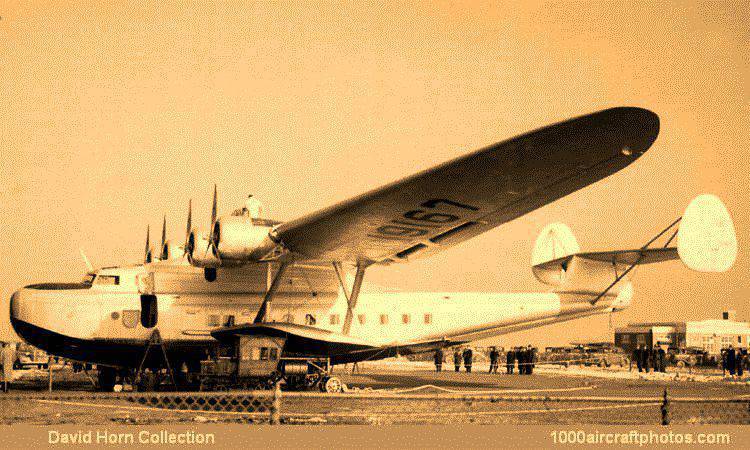
В stories domestic aviation many pages are related to the development and operation of foreign aircraft. One vivid example of this is the story of the acquisition by the Soviet Union of the American transatlantic flying boat M-156 Glenn Martin.
It was reliably established that in the mid-thirties of the USSR, in accordance with the doctrinal guidelines for the development of the theory and practice of a deep offensive operation in the context of a worsening military-political situation in the world and the emergence of two centers of possible unleashing a new world war (in the West - Germany and in the East - Japan ) headed for the intensive improvement of its military aviation, including naval. This required long-range naval bombers and reconnaissance aircraft capable of taking off both from land and from the sea.
In addition to creating and developing its own aviation base and technology, the Soviet government sought to adopt advanced foreign, including American, experience. Moscow’s choice of the United States as a business partner was not accidental. Pre-revolutionary Russia and America were tied up by fairly old military-technical ties, including in naval aviation. The initiator in these matters was the Russian Maritime Department. So, by his orders in 1911-1916. for the imperial fleet 148 copies of American Curtis aircraft were purchased (although, in fairness, it is worth noting that only about fifty of them were assembled and put into operation).
With the establishment of Soviet-American diplomatic relations in November 1933, contacts were resumed with US aviation companies through the Commissariat of Defense and Aviation Industry of the Soviet Union. At the same time, they focused on those firms in which Russian emigrants worked. Already in the 1935, the USSR passed the tests of the American two-seater Scout 2E Northrop. In 1936-1938 in the United States were purchased, mainly for licensed construction, in unit copies of the aircraft РВY-1-3 "Shkval", "Valti" V-IA in the passenger version), "Consolidated" HRVY-I, "Valti "V-IA (float, in passenger version), and also" Valti "V-II (BS-1, Vulti) - 5 units; "S-43" - 2 units; "Douglas" DF (DF-2-195) - 2%; "Douglas" DS-3 and C-47. Of these, the introduction of the Valti V-II as a scout, attack aircraft and light bomber, was engaged in the design bureau S.A. Kocherigina, "Consolidated" HRVY-1 as a twin-engine long-distance maritime intelligence officer - KB G.M. Beriev, "Douglas" DS-3 as a transport plane - Design Bureau 3 M.V. Myasishchev.
The supply of licensed aircraft from the United States was carried out by the Soviet Union on the basis of contracts for technical assistance with US firms. Such contracts were concluded: from Curtis-Wright (for 5 years, from 1933-th to 1938 year), with Valty (for 1 year, 1937-1938), with Consolidated (for 1 year, 1937-1938, from Douglas (at 2 of the year, from 1937-1939), from Seversky Aircraft Corporation (at 2 of the year, from 1937 to 1939). By decision of the Soviet government dated June 1936, Amtorg Joint-Stock Company 12 September 1936 of the year in Washington concluded a similar agreement with the firm Glenn L. Martin Company. The contract was designed for 3 of the year (until 12 of September of 1939 of the year) and provided for the company to create an experimental version of a four-engine flying boat for passenger and transport on the Ocean-Clipper transoceanic lines, and its subsequent delivery to our country.
The new seaplane, which received the designation M-156 "Glenn Martin", was created on the basis of the flying boat "Glenn Martin-130", better known on the long-distance transoceanic air routes as the "China Clipper". The difference between the M-156 model and its predecessor was the greater flight weight (by 4570 kg), in increased geometrical dimensions, more powerful powerplant, new tail assembly and a number of other innovations.
The M-156 Glenn Martin had a compact, fairly free cockpit for a crew of two pilots, a navigator, a flight engineer and a radio operator. For passengers on the plane, there were 3 ten-seat cabins and one cabin for 16 seats, which, if necessary, could be converted into 26 berths. In addition, for passenger service, the boat had a buffet, two restrooms and, in the cabin, a spare washbasin (in the table), which a 4 person could use at the same time. The seaplane was equipped with life jackets and inflatable boats for all passengers, there were also bedding and kitchen equipment. In the tail section there were baggage cabs, and in the forward compartment there was a post office. In addition, 2 cots were installed behind the luggage cabins for crew members to rest. The power plant consisted of a Paradise-Cyclone 4-x engines, having an 1000 horsepower take-off power.
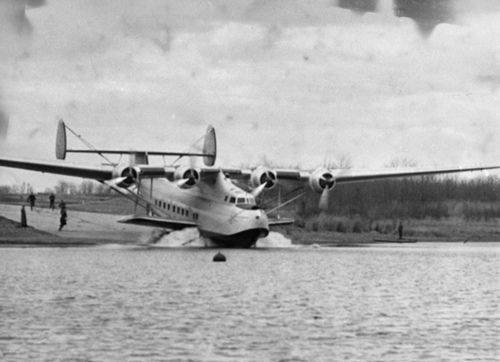
Developing a new flying boat, the Americans believed that the Glenn-Martin M-156 the Soviet Union will use for experimental Arctic flights. However, on April 22 1937, the Special Service Station of the USSR, adopted Resolution No. 78, according to which this seaplane was to be produced in the Soviet Union in the version of the marine heavy bomber MTB-3. Serial production was planned to begin at aircraft factories in Taganrog and in Komsomolsk-on-Amur. After receiving in the autumn 1936 of the drawings from the American company, in parallel with the manufacture of a seaplane in Baltimore, in the USSR in the design bureau P.D. Samsonov began work on the development of a special bomb deck for the M-156, for the suspension of aerial bombs, which was located in the redan of a flying boat. The well bomb-hole had rather large sizes, its length was equal to 5 m, and the width of 1,2 m. Part of the redan at the keel formed large hinges. It was an original and unusual decision. Somewhat later, a similar task had to be solved by the British on their flying boat, the Short Sunderland. The British also placed bombs in the fuselage, while for dumping them together with holders along rail guides they pushed under the plane of the wing through side hatches.
In the summer of 1937, in KB, a model of a flying boat with bombs and devices for loading and suspension of large-caliber bombs, as well as the deployment of defensive weapons and target equipment, was made. In the military version it was planned to install screened turrets, which were located in the bow and stern extremities and behind the wing of a seaplane. In addition to these three firing points, the aircraft carried machine guns in the side windows of the aircraft. In those years, the installation of this type were called ream. In addition, the Soviet designers were working on the possibility of equipping the M-156 with a single-fin plumage, like TB-4.
It is worth noting the fact that the construction of the aircraft in the United States was also under strict control of the 7 department of the State Security Department of the NKVD, which regularly sent reports on the state of affairs at the company addressed to the People's Commissar of Internal Affairs N.I. Yezhov and People's Commissar of Defense K.E. Voroshilov.
7 November 1937 of the year in Baltimore, the first flight of the Glenn Martin M-156. From 22 in November of the same year to 13 in January of 1938, the aircraft underwent factory tests with an attack around 50 h. To receive the 19-20 boat in January 1938, the Soviet commission was sent consisting of: Chairman of Amtorg Zagainov, engineers Borisenko, Kozlov and pilot Yershov . This was done 3 flight duration 5 hour. 9 min.
Having accepted the aircraft, in the acceptance report and report the commission indicated the following prospects for its use in the military version:
A. The use of this aircraft as a heavy bomber is impossible without serious modernization. Modernization under this option will require major design changes. Placement of the ejected load inside the boat, with a radical modification of the central part of the boat, will be required. Installing small arms will also require rework. As a result, the weight of an empty machine increases and speed decreases. Probably, the speed in this case will be lower than the minimum that is required for a modern bomber.
B. Changing the layout of the aircraft or increasing the strength will require a lot of time and will actually give a new type of aircraft.
Further, Soviet experts noted: "Considering it expedient to train personnel to build this type of aircraft, the commission considers it possible to use this aircraft for the following purposes:
a) passenger and transport links on the sea lines of the civil air fleet;
b) when the aircraft is armed with protective equipment and re-equipment of the navigator's cabin - use for landing operations both airborne and landing, at the enemy’s coastline;
c) as a staff aircraft - to control the naval forces in combat;
d) as a training aircraft for all services of the Air Force.
During the test flights, the Glenn Martin M-156 showed good flight data, reaching a maximum speed of 274 km / h and a range of 5000 km. In February, 1938, a boat disassembled on a steamer, was taken to Leningrad, where it was assembled and transferred to Moscow on the Khimki reservoir. Here the aircraft was handed over to the naval aviation command of the Navy Commissariat. The crew of test pilot Captain Shevnik on the "Glenn Martin" made 13 flights. March 3 1938. Deputy Narkom of the Navy P.I. In his report to the USSR People's Commissar of the Defense Industry, Kaganovich, Smirnov clearly concluded that the M-156 was of an outdated type and was unsuitable for armament of naval aviation, giving preference to the MTB-2 national hydroplane.
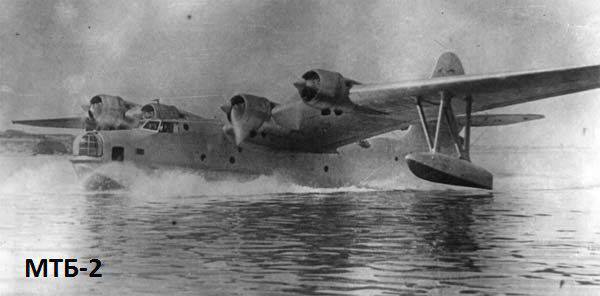
Another circumstance playing against the adoption of the national naval aviation by the M-156 was the fact that the seas of the Soviet Union are freezing. Throughout the year, hydroaviation could work only in the Black Sea, and even then not everywhere, in other fleets - from five to seven months. The remaining time flying boats will be laid up, or they must be equipped with a ski landing gear, like the Soviet ICBM-2. It was also clear that the huge American aircraft would require significant investments in the development of coastal base infrastructure. It was necessary to equip mechanized slips, since such a large machine cannot be rolled out manually. It was also necessary to build large hangars to store the aircraft in the winter and repair in the summer. The full-fledged operation of the M-156 was impossible even without filling stations - a four-engined seaplane would have to be filled with buckets all day. This vehicle could be transferred from one sea to another, it was possible only under its own power or on a ship, since M-156 did not understand the nodes that ensure its transportation by rail. Fleet leadership began to oppose the transfer of M-156 into production. The fleet was also supported by the leadership of the aircraft plant No. XXUMX, which was by no means willing to develop an American seaplane, which was huge and extremely difficult for the Soviet level of production. Back in early November 30, it raised the question of the feasibility of launching it into mass production.
And what happened to the first plane? In the summer of 1938, the naval aviation command decided to transfer the new seaplane to the Black Sea Fleet, and on August 4 the crew arrived in Moscow to distill it in Sevastopol. By this moment, it became clear that the low-speed giant seaplane should be replaced by a land bomber and a torpedo bomber, with large speeds and a half. At the request of transport aviators, the fleet transferred the Glenn Martin M-156 to Aeroflot.
21 September 1938 the aircraft was received from the UMA NK Navy by the Aeroflot Commission and handed over to state tests at the Scientific Research Institute of the Civil Air Fleet. In the 1938 year, due to unfavorable weather and the impossibility of flying with full flight weight, only part of the state tests were carried out. For wintering, the boat climbed to the concrete descent of the plant number 156 Khimki reservoir. 25 May 1939, the Glenn Martin seaplane M-156 under the name PS-30 with the factory number 714 and the identification mark L-2940 was enlisted in the register of civil aircraft of the USSR.
20 June 1939, the boat was again launched to continue testing. She made another 54 flight. After that, by order of the Chief of the Main Directorate of the Civil Air Fleet, the flying boat was transferred to the Far Eastern Directorate of the Civil Air Fleet with a permanent location in Khabarovsk. Since the summer of 1940, the Glenn Martin M-156 has begun to master one of the longest air routes of union importance with the carriage of passengers along the Far Eastern routes. According to the routes, this seaplane flew during the Great Patriotic War, making a 1 flight once a week, in summer and winter.
The main problems in the operation of "Martin" delivered the engines. Their production in the United States has already stopped, so new engines for the M-156 could not be purchased there. For this reason, in 1942, the plane flew just 82 hours. In February, the Wright engines began to replace the Wright engines with domestic ASH-1943IR, similar in characteristics and dimensions.
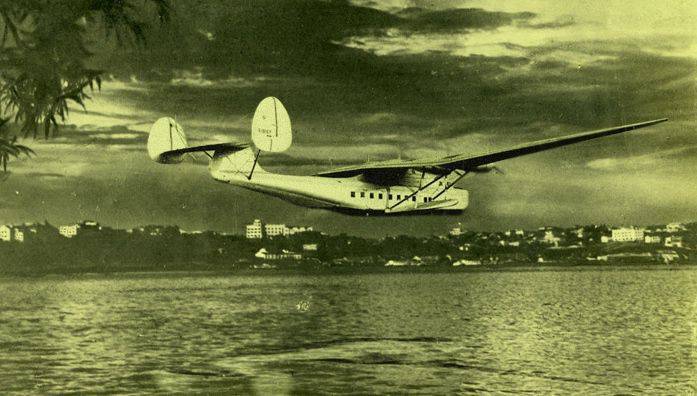
By the beginning of the summer navigation 1943, a seaplane with a power plant consisting of Soviet and American engines, was again prepared to fly. PS-30 continued to operate on flights Khabarovsk-Petropavlovsk. In October, the seaplane made a special flight. He delivered to Khabarovsk the crews of the Allied bombers who made forced landings on Kamchatka. Then the pilots were brought under Tashkent, where a prefabricated camp was organized. Subsequently, the Allies, observing secrecy (according to the Soviet-Japanese treaty, the American pilots were considered interned), were transferred to Iranian bases. The PS-30 flight intensity was affected by the lack of aviation gasoline in Kamchatka, but even so, the 1943 raid year reached 115 flight hours.
Until August 1944, the seaplane flew another 76 hours, after which it was finally laid up for joking due to the presence of numerous faults. In February, 1946 was ordered by parts of the order of the Chief of the Main Directorate of the Civil Air Fleet PS-30. Thus ended the fate of the "flying American" in the Soviet Union.
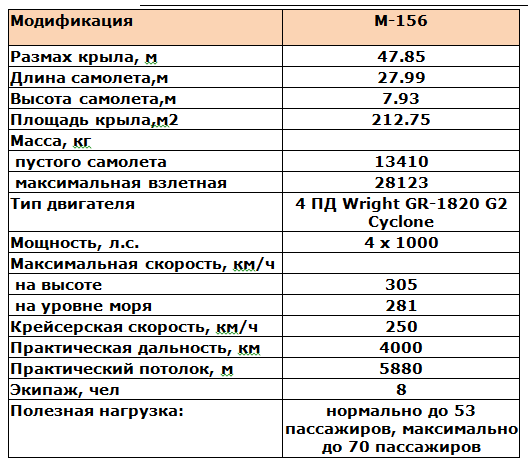
Sources:
Kotelnikov V. From "Martin-156" to PS-30 // Avimaster. 2002. No.7. C.26-32.
Maslov M. Flying boat "Martin-156" // Wings. 2010. No.2. C. 37-38.
Pocharev A. Transatlantic flying // Sea collection. 2000. No.3. C.46-48.
Petrov G. Seaplanes and WIG Russia 1910-1999. M .: Rusavia. 2000. C. 206-207.
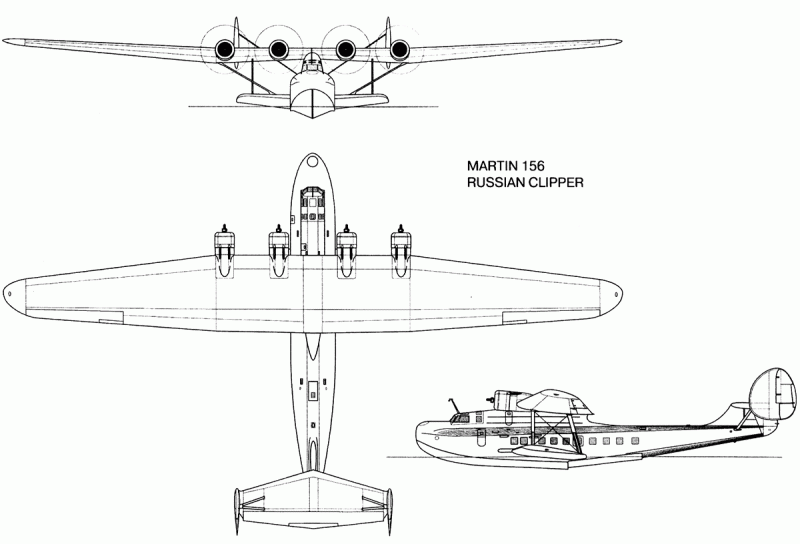
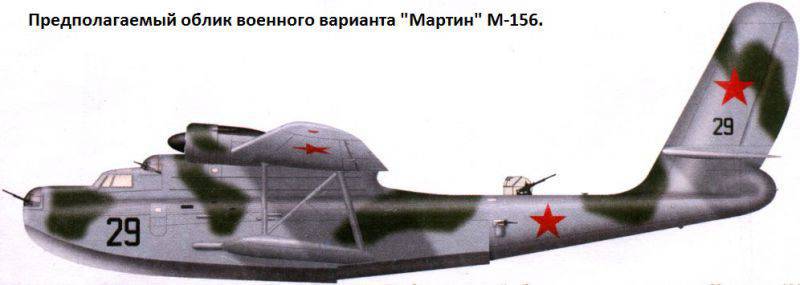
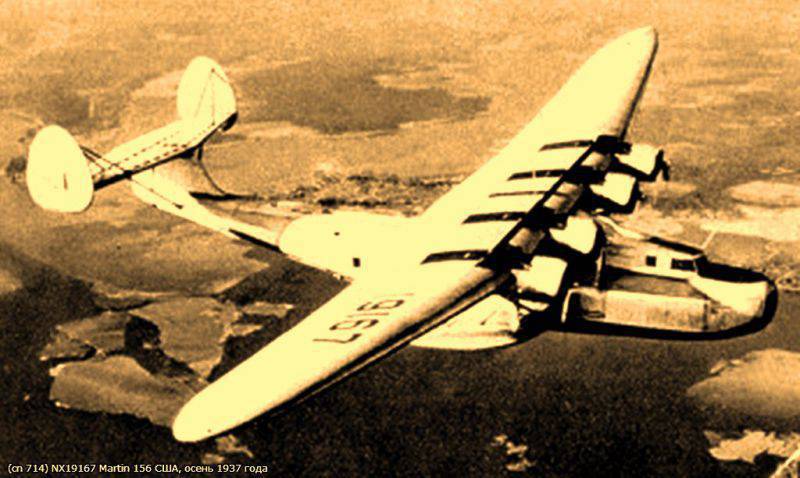

Information